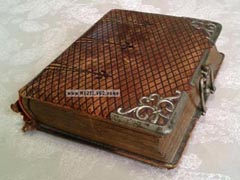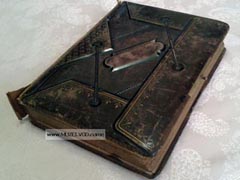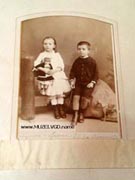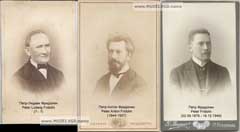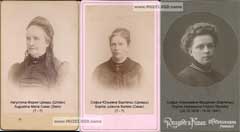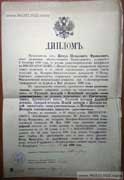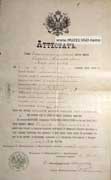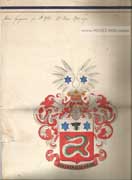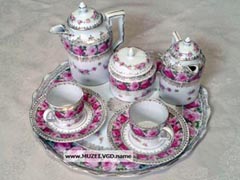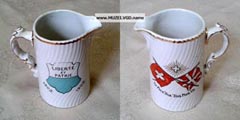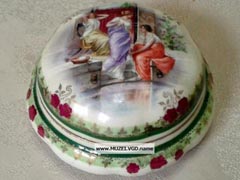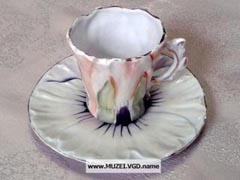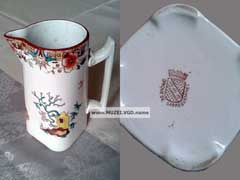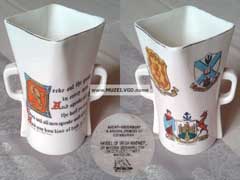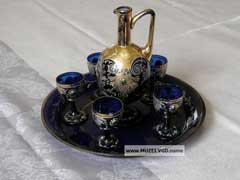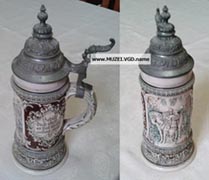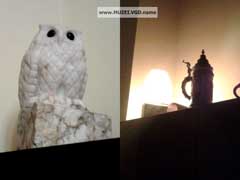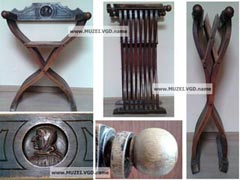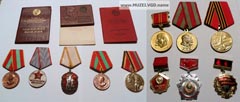История рода ДраконберговНаше государство создано в память о наших предках и основано на древних семейных легендах. Картинки в верхней части данного раздела символически отражают "Историю рода Драконбергов", прочитать которую можно на сайте эпоса. Естественно, что чем ближе к нашим дням, тем достовернее информация. Семейные предания говорят, что на рубеже 18-19 веков наш предок по политическим мотивам переселился из Швеции в Россию, где он утратил фамилию "фон Драконберг" (возможно, тоже из-за политики), а одно из его имен - Фридолин - стало фамилией. На фото ниже можно увидеть трех известных его потомков, живших уже в России (Петербурге): Петра-Людвига, Петра-Антона и просто Петра (который и является прадедушкой нынешнего Главы ВГД). Петр-Антон был медиком, в конце 19 века он за свои заслуги перед государством получил наследуемое дворянство (герб также представлен на фото ниже). Его сын Петр (историк) вместе с семьей в 1923 году переселился в Азербайджан, другие его родственники остались в России. К сожалению, мы пока не знаем наших предков старше Петра-Людвига, да и о нем самом сведений у нас почти нет. Но мы верим в то, что указанная легенда имеет под собой реальные основания, тем более что существуют ее косвенные подтверждения. В годы советской власти мало кто задумывался о своем происхождении (тем более, дворянском), поэтому, к сожалению, информации о прошлом у нас не много. Однако, одна из целей создания государства - исследование этого прошлого, поиск документов, а также других представителей нашего рода в разных странах. Разумеется, на этой странице собраны далеко не все имеющиеся в музее реликвии, а только наиболее интересные и характерные. Реальный музей занимает довольно большое пространство и содержит сотни экспонатов, но выставлять их на сайте не всегда возможно и не всегда в этом есть смысл. На этой странице собрано то, что относится непосредственно к истории, но если быть точным, то весь Государственный музей ВГД в какой-то мере отражает нашу историю. На отдельной странице приведены сведения о знаменитых представителях рода. Естественно, что не все они были прямыми потомками Драконбергов, но все они - предки нынешних граждан ВГД. С историей самого Виртуального Государства Драконберг можно ознакомиться в разделе "История ВГД". |
The History of Drakonberg FamilyOur state created in memory of our ancestors and based on ancient family legends. Images at the top of this section symbolically represent the History of Drakonberg Family which can be read on the website about epos. According to family legends, at the turn of the 18th and 19th centuries our ancestor for political reasons moved from Sweden to Russia, where he lost the surname "von Drakonberg" (perhaps also because of politics), and one of his name - Fridolin - became the surname. In the photo below you can see three his known descendants who lived already in Russia (Petersburg): Peter Ludwig, Peter Anton and Peter (who is the great-grandfather of the current Head of Drakonberg). Peter Anton was a physician; at the end of the 19th century, for his merits to the state, he received an inherited nobility (the coat of arms is also shown in the photo below). His son Peter (historian) with his family moved to Azerbaijan in 1923, while his other relatives remained in Russia. Unfortunately, we do not know our ancestors older than Peter Ludwig yet, we have also almost no information about him. But we believe that this legend has a real basis, especially since there are indirect confirmations of it. During the years of Soviet power, few people thought about their origins (especially nobility), therefore, unfortunately, we don't have much information about the past. However, one of the purposes of our State is to research our past, and also search for documents, as well as other members of our family in different countries. Of course, not all relics available in the Museum are shown on this page, but only the most interesting and characteristic. The real Museum occupies quite a large space and contains hundreds of exhibits, but it's not always possible and not always makes sense to put them on the website. On this page is collected only exhibits that relates directly to History, but to be precise, the whole Museum of Drakonberg in some way reflects our history. Information about famous members of our Family presented on another page. Naturally, not all of them were direct descendants of Drakonbergs, but they are the ancestors of the current citizens of Drakonberg. A special page is dedicated exactly to the history of the Virtual State of Drakonberg. |
|
Важнейший экспонат любого исторического музея (тем более, семейного) - это старые альбомы фотографий. Данный экземпляр относится к началу 20 или даже концу 19 века. The most important exhibit of any historical museum (especially family) - it is the old photo albums. This album belongs to the early 20th or even late 19th century. |
|
Это второй старинный альбом, также содержащий семейные фотографии наших далеких предков из рода Драконбергов. This is the second vintage album containing family photographs of our ancestors. |
|
Прабабушка нынешнего Главы ВГД и ее брат. Одна из самых старых фотографий альбома (сделана в 1883 году, о чем есть надпись в альбоме). The great-grandmother of the current Head of Drakonberg and her brother. One of the oldest photo of the album (made in 1883, according to the inscription in the album). |
|
Семейный портрет. Бабушка Главы ВГД с братом и их родители, фото начала 20 века. Family photo. The grandmother of the Head of Drakonberg with her brother and their parents, photo of the early 20th century. |
|
Наши предки: Петр-Людвиг, его сын Петр-Антон, сын Петра-Антона Петр (прадед Главы ВГД). Our ancestors: Peter Ludwig, his son Peter Anton, Peter Anton's son Peter (great-grandfather of the Head of Drakonberg). |
|
Наши предки: Августина-Мария, ее дочь София Юльевна, дочь Софьи Юльевны Софья Алексеевна (жена Петра Фридолина, прабабушка Главы ВГД). Our ancestors: Augustina Maria, her daughter Sophie Julievna, Sophie Julievna's daughter Sophie Alekseevna (wife of Peter Fridolin, great-grandmother of the Head of Drakonberg). |
|
Диплом об окончании историко-филологического факультета Санкт-Петербургского университета, выданный Петру Фридолину. Diploma from the Faculty of History and Philology of the St. Petersburg University, issued to Peter Fridolin. |
|
Аттестат об окончании Женской гимназии с правом работать домашней учительницей, выданный Софии Бартельс, будущей жене Петра Фридолина. Graduate certificate of the Women's Gymnasium with the right to work as a home teacher, received by Sofia Bartels, the future wife of Peter Fridolin. |
|
Герб рода Фридолин. Наследуемое дворянство получено Петром-Антоном в конце 19 века. Coat of arms of Fridolin Family. Inherited nobility received by Peter Anton at the end of the 19th century. |
|
Утренний сервиз "Тет-а-тет". Утренний сервиз (набор посуды) на двоих. Содержит кофейник, молочник, сахарницу и две чашки. Точная дата изготовления и страна неизвестны. По преданию, этот сервиз подавался прислугой в постель после пробуждения наших предков, возможно, не одного их поколения. Morning service "Tete-a-tete". Morning service (set of dishes) for two. It includes coffee pot, milk jug, sugar bowl and two cups. The exact date and country of manufacture are unknown. |
|
Памятный молочник 1903 года. Молочник с гербом швейцарского кантона Во, посвященный столетию утверждения нового герба кантона, присоединившегося к Швейцарии в 1798 году. Девиз на молочнике - "Один за всех, все за одного". Вы можете посмотреть виды города Мудон, расположенного в данном кантоне. Memorative milk jug 1903. The milk jug with the emblem of the Swiss canton of Vaud, dedicated to the centennial of the approval of the new coat of arms of the canton, joined the Swiss in 1798. The motto on the jug - "One for all and all for one". You can also see views of the Moudon city, located in this Canton. |
|
Старинная пудреница, использовалась женщинами нашего рода в 19-20 веках. Vintage powder box, was used by the women of our Family in the 19-20 centuries. |
|
Эта кофейная чашка, пожалуй, самая красивая из немногих сохранившихся с тех давних пор. Активно использовалась до середины 20 века, сейчас - просто экспонат музея. This coffee cup is perhaps the most beautiful of the few preserved since ancient times. Was actively used until the mid 20th century, now just a Museum exhibit. |
|
Кувшин для подачи молока к столу (предположительно). Этим кувшином, возможно, пользовались в начале прошлого века, но на памяти ныне живущих граждан ВГД он всегда был просто экспонатом. The jug for serving milk (presumably). This jug, probably, was used at the beginning of the last century, but currently, it is just an exhibit. |
|
Старинный кубок неизвестного назначения. На памяти нынешних жителей Драконберга никогда не использовался. Model of Irish mather or wooden drinking cup in Dorset County Museum. |
|
Графин с набором рюмок конца 19 века. Венецианское стекло и позолота. К сожалению, из 6 рюмок сохранились только 5. Набор использовался еще в середине 20 века, но потом стал просто экспонатом музея. Decanter with set of glasses of the late 19th century. Venetian glass with gilding. Unfortunately, only 5 of the 6 glasses were preserved. The set was used till the middle of the 20th century, but then it became just an exhibit of the museum. |
|
Классическая немецкая пивная кружка с откидной крышкой. Присутствует в коллекции с рубежа 19-20 веков. Предки любили хорошее пиво... A classic German beer mug with a hinged lid. Present in the collection from the turn of 19-20 centuries. Our ancestors loved a good beer... |
|
Каменный ночник в виде совы, сделан предположительно в начале 20 века (или раньше). Изначально в нем использовалась свеча, помещаемая внутрь совы. В середине 20 века переделан под электричество. На фотографии ночник показан днем и ночью во включенном состоянии. A stone night lamp in the form of an owl, made at the beginning of the 20th century (or earlier). Initially, it was used a candle, placed inside the owl. In the middle of the 20th century, it was modified for electricity. In the photo the night lamp is shown turned off and on. |
|
Кресло Савонаролы. Джироламо Савонарола (1452—1498) — итальянский монах, поэт, проповедник и реформатор. Известно, что складное кресло с портретом Савонаролы, представленное на фотографии, сопровождало наших предков на протяжении многих десятилетий. Именно оно вдохновляло их на творчество и научные открытия. Да и сейчас в нем приятно сидеть, хотя в конце 20 века кресло стало музейным экспонатом с целью предохранения его от возможных повреждений при эксплуатации. Кресло ручной работы, изготовлено из дерева, ручки кресла вместе с вращающимися кольцами вырезаны из цельного куска древесины, без швов. По преданию, оно изготовлено в Италии в честь 400-летия со дня рождения Дж.Савонаролы. Armchair of Savonarola. Girolamo Savonarola (1452-1498), was an Italian monk, poet, preacher and reformer. This folding armchair with a portrait of Savonarola, accompanied our ancestors for many decades. It inspired them at creativity and scientific discoveries. And now it is nice to sit in it, although in the late 20th century it became a Museum exhibit, to protect it from possible damage during exploitation. The armchair is handmade, made of wood, the chair arms with the rotating rings carved from a single piece of wood, without seams. According to legend, it was made in Italy in honor of the 400th anniversary of the birth of Savonarola. |
|
Чудесный посох. Известно, что этот посох принадлежал брату бабушки нынешнего Главы ВГД (на посохе есть монограмма с инициалами "МФ"). Известно, что он широко использовал посох в своих походах и творческих командировках. В те годы любая мистика находилась под запретом, однако до нас дошли некоторые странные истории, связанные с чудесными свойствами этого посоха. Он всегда спасал своего владельца в трудных ситуациях в дикой природе, но, увы, не смог спасти его от голодной смерти во время блокады Ленинграда в годы войны с фашистами... Впрочем, возможно, посох в то время уже был в Баку, у его сестры. Точно это сейчас установить невозможно (как и правдивость тех историй), но в противном случае, скорее всего, он бы просто не сохранился в Ленинграде. Посох действительно имеет необычный вид и достаточно сильную энергетику. Но откуда он появился в семье предков, кто и когда его изготовил и почему он обладает столь необычными свойствами, сейчас уже установить невозможно. Magic staff. We know that this staff belonged to the brother of the grandmother of the current head of Drakonberg (on the staff there is a monogram with the initials "M.F."). We know, that he widely used this staff in his expeditions and creative trips. In those years, any mysticism was taboo, but we heard some strange stories related to the wonderful properties of this staff. It always saved its owner from hardship in the wild, but, alas, could not save him from starvation during the siege of Leningrad during World War II... However, perhaps at that time the staff was already in Baku. Now it is impossible to set is it true, but otherwise, most likely it would have not preserved in Leningrad. The staff really has an unusual appearance and rather strong energy. Now it's impossible to determine when, where and by whom it was made, how it came to our ancestors and why it has such unusual properties. |
|
Ордена и медали СССР, полученные нашими предками в годы Второй мировой войны и после ее окончания. Orders and medals of the USSR, received by our ancestors during the World War II and after its termination. |
